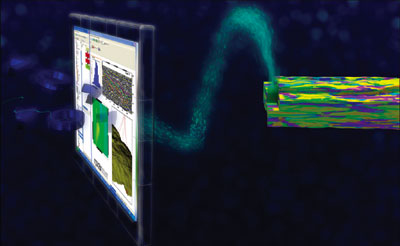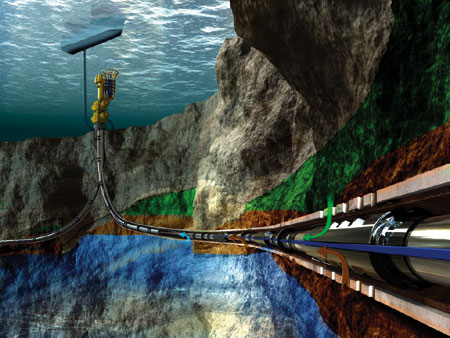|
 |
|
|
New or existing work-flows can be turned quickly into uncertainty workflows through easy-to-use software solutions, without resorting to scripting or manual setup. A series of dynamic analysis tools can pre-empt the need to build up complex, time-consuming fine-scale models.
Furthermore, rather than storing the complete 3D model with its hundreds of accompanying realizations and the memory implications that come with it, today’s modelling packages can store table-based reports and scenarios that can be reproduced easily for more in-depth analysis.
Roxar is looking to add an uncertainty module to its IRAP RMS modelling solution, which will quantify the effects of uncertainties on volumes and cumulative production, to ensure that less risky decisions are made. Post-processing features will include tornado charts (designed to analyze the results in a statistically robust manner), and probability cubes. to help identify drilling locations.
Capturing uncertainties in dynamic environments. While static analysis can give a lot of valuable information about the reservoir, only dynamic analysis of the reservoir can fully quantify what the impact of uncertainties will be on reservoir performance. This is where simulation comes into its own.
The last few years have seen a growth in the ability of reservoir simulators to measure uncertainty within a dynamic environment. Simulators, such as Roxar’s Tempest are able to examine numerous geological scenarios that can be history-matched to create simulation models that are fully consistent with their underlying geological interpretations.
The intelligent downhole network. Uncertainty management can only be improved, if one is able to acquire quality data on subsea operations. A key means of achieving this is through permanent downhole and pressure gauges – essential in monitoring reservoir and well data, Fig. 2.
 |
|
|
Placed between each production zone and utilized not only to monitor temperature, pressure and water cut, but also gas fraction, sand rate and flow velocity, the sensors can continuously monitor the production performance parameters of each individually perforated zone of a multilayer well. By forming an intelligent downhole network, reservoir knowledge is increased and uncertainty is reduced.
Conclusion. While drilling more wells, performing new seismic surveys and running multiple log runs might help to reduce uncertainties, it is in the quantification of these uncertainties that operators can more fully understand risk.
By generating multiple plausible realizations, analyzing the results in a robust manner; incorporating the statistics in decision-making within a dynamic, simulation environment; and utilizing one’s measurement tools; reliable decisions can be made with the maximum amount of information. ![]()
David Hardy is product manager for reservoir interpretation and modelling in Roxar’s Software Solutions Division. Working closely with Roxar’s development and regional sales groups, Mr. Hardy works to provide innovative software solutions to help clients better understand their reservoirs, increase productivity and minimize risk. He joined Roxar in 1997 and has more than 12 years of experience in the E&P industry. |
Comments? Write: editorial@worldoil.com |
- Advancing offshore decarbonization through electrification of FPSOs (March 2024)
- Subsea technology- Corrosion monitoring: From failure to success (February 2024)
- Driving MPD adoption with performance-enhancing technologies (January 2024)
- Digital transformation: A breakthrough year for digitalization in the offshore sector (January 2024)
- Offshore technology: Platform design: Is the next generation of offshore platforms changing offshore energy? (December 2023)
- 2024: A policy crossroads for American offshore energy (December 2023)

 Technology from Europe:
Technology from Europe:
